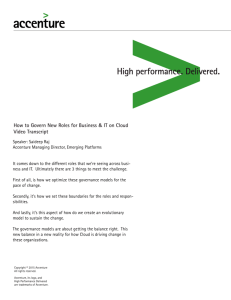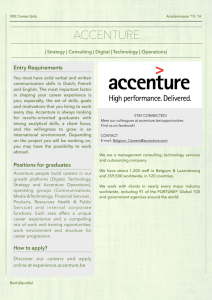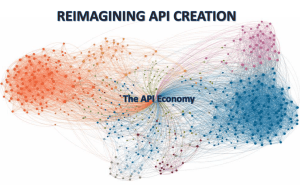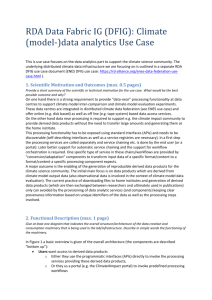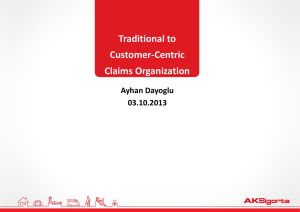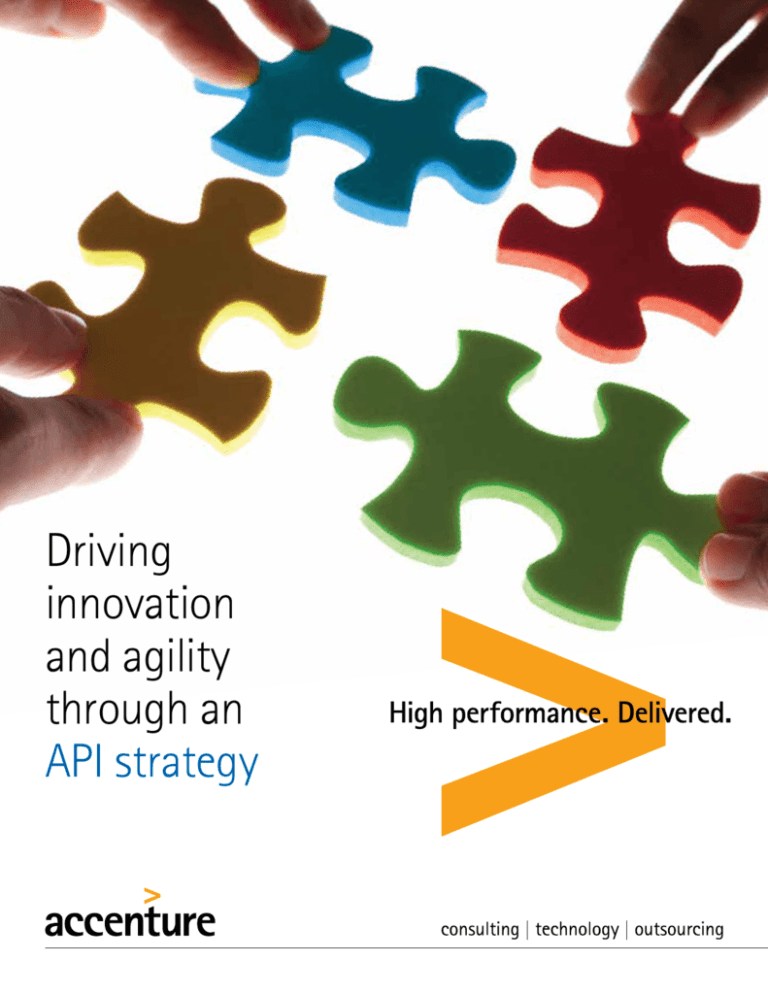
Driving
innovation
and agility
through an
API strategy
Today’s Application Programming Interfaces (APIs) are
business-level artifacts that enable new business models and
modes of efficiency such as: interacting with customers over
new mobility and social channels, reaching new customers
through partner and 3rd party apps, monetizing your data and
services for use by others and maximizing IT efficiency. Across
these scenarios, APIs are keys to scale IT capability and unlock
business innovation and agility.
Traditionally APIs remained the concern
of IT because they were primarily viewed
as standard interfaces to interact with
underlying hardware and software. No
longer—today’s APIs offer a simplified
interface to access valuable business data
and functionality through Internet standards
that developers understand. For example:
A Common Services Platform: An
organization building applications for
multiple platforms (be it for Cloud,
Social or Mobility) presents a set of
common functionality via internal APIs
to standardize data and service access in
order to minimize rework. Consider the
case of Mobility. With the exponential
growth of mobile devices, most companies
are seeing their customers move quickly
beyond browser-based web apps to mobile
apps. Having a common set of functionality
reduces the work involved in developing
applications for multitude of mobile
platforms such as iOS, Android, Windows
and Mac.
A Self-Service Model: Organizations also
use APIs to enable self-service models
that empower internal groups, partner
organizations and independent developers
to enhance functionality on their own
without being limited by only what can
be done by their IT department. Some
examples include: an individual developer
extending capability to the Linux platform,
a partner organization embedding your
service within a mash-up, or an internal
department refactoring data for a groupspecific dashboard.
A Unique Offering: Public or open APIs
provide unique services or data that is
not available elsewhere, possibly offering
opportunities for monetization if broadly
adopted. For example, Netflix’s use of
Amazon Web Services Elastic Compute
Cloud APIs1 means that as Netflix gets
more popular, the usage of Amazon’s API
increases, resulting in financial gains for
Amazon.
APIs serve as the fixed point that
decouples access from IT implementation,
allowing each to evolve independently: IT
can innovate and update back-end systems
at the pace of technology. For example, it
can modernize a legacy mainframe backend system without impacting access
systems, allowing users to continue to
access the sames APIs. And the right set
of APIs enables a framework for internal,
partner and external users to reuse, evolve
and scale your capability: new users and
use cases can begin consuming your data
and services via APIs without need to
re-implement your back-end services.
But just having APIs is not enough. There is
a big difference between an ad hoc set of
APIs compared to a carefully curated and
managed set. Achieving the latter requires
an API program that covers the APIs
through strategy, governance, design, build
and operate. Together the stages work
towards specific outcomes such as creating
a common services platform, a self-service
model or a unique offering.
1
http://tech.fortune.cnn.com/tag/amazon-web-services/
When there are only a handful of APIs,
creating them ad hoc makes good sense.
However, the number of APIs can grow
quickly, and keeping track of their versions,
number of users and types of access
quickly introduces complexity, and standalone services will not be enough to attract
and retain users. Without visibility into
who is using your APIs, it is difficult to
determine which APIs and access are truly
important. For example, IT monitoring is
insufficient and does not identify what
access and whose access drives the load.
Inconsistent application of policies and
development of APIs introduces business
and IT vulnerability that may lead to
overexposure in terms of security and
compliance. Ad hoc management makes
it difficult to pinpoint and resolve these
issues. The result is that access and
implementation are either still tightly
coupled, making dealing the APIs no better
than working directly with details of
backend systems; or uncontrollable where
the complexity of APIs becomes too great
to manage. Without a structured approach,
APIs lose the simplicity that makes them
valuable.
APIs are quickly being promoted as
something every organization needs given
the need to share data across applications.
They provide a common platform of
functionality that minimizes rework and
accelerates development. The questions
then become, "what can they do for my
organization and how do I get started?"
As technical components alone, APIs can
be simple to build, but by themselves only
enable access. The challenge and reward
lies in creating an API program directed to
a common goal. The key elements are 1) a
compelling set of services that will attract
and satisfy users, and 2) a standardized
governance and management model for
consistent operations. As a result, they
ultimately enable a self-help model for
developers and also help your business
innovate and grow.
Accenture API
Management Suite
Accenture API Management Suite drives a
unified approach across the API lifecycle
stages to create and manage a curated set
of APIs that achieve business innovation
and agility:
Strategy: First, set your business goals
and value proposition for your APIs.
Determine what outcomes you want the
APIs to generate within the context of your
business model. APIs for a partner program
may be free of charge when supporting
co-innovation, or be monetized based on
bulk usage when delivering partner value,
or piggy-back a per use charge when the
partner channel drives requests. Start by
considering: Who are your end-users? What
outcome does your set of APIs enable? How
it is different from others on the market?
Governance: Consider the risks associated
with your strategy, and identify the API
owners and sponsorships to understand
associated levels of responsibility. Riskwise, governance follows the data. First,
determine the data impacted by the
proposed API. Then work with the data
controllers responsible for the data to
determine the exposure granted by the API
and to authorize and scope access.
Design: Define exactly which APIs are
needed from a technical perspective,
focusing on what each API will do to
achieve the desired business outcomes and
meet governance objectives. The result
will be a set of API definitions. Consistent
application of best practices around error
handling, security, implementation (REST,
HTTP), results in a well-defined set of
APIs that attracts users because they can
achieve their objectives and access unique
services.
Build: Implement the APIs. Standardized
development frameworks and implementation
patterns ensure the consistent application
of designed best practices (e.g., around
security, traffic management, service level
management, monitoring, metering,
monetizing and analytics). This structured
approach minimizes risk and rework.
Operate: Leverage API management tools
such as those from Apigee, Layer 7 and
Mashery to manage and monitor the APIs.
Visibility into what APIs are accessed, who
is accessing them and how they are being
used are key to understanding run-time
optimization and analytics that will inform
and improve your API strategy.
An API program is not a one-time
process, but an agile model that is
dynamic, responding to changing business
conditions and requirements. Accenture
API Management Suite helps companies
regularly revisit the stages of the API
lifecycle to effectively allocate resources
and introduce updates (e.g., add/remove
APIs, monetize, versions, etc.) based on
changes in usage and the desired goals.
Questions to consider
1. If you are currently embarking on a
Mobility, Social, Data or Cloud program, how
are you going to access data and services?
2. Do you have valuable data or unique
services that may be of interest to others?
3. Do your competitors have APIs?
4. If you currently have APIs: Do you know
if your program successful? Do you know
your end-users? How do you differentiate
your APIs from others?
Accenture can help businesses develop an
API-led strategy that will yield optimal
business results.
Contact us
To discuss developing or refining a strategic
API program, contact us:
Edy Liongosari
Managing Director—Accenture Technology
Labs
edy.s.liongosari@accenture.com
Teresa Tung
Senior Manager—Accenture Technology Labs
teresa.tung@accenture.com
Jean-Marie Hunold
Global Lead—ETI Integration Domain
jean-marie.hunold@accenture.com
4
About Accenture
Technology Labs
Accenture Technology Labs, the dedicated
technology research and development
(R&D) organization within Accenture, has
been turning technology innovation into
business results for more than 20 years.
Our R&D team explores new and emerging
technologies to create a vision of how
technology will shape the future and invent
the next wave of cutting-edge business
solutions. Working closely with Accenture’s
global network of specialists, Accenture
Technology Labs help clients innovate to
achieve high performance. The Labs are
located in Silicon Valley, California; Sophia
Antipolis, France; Arlington, Virginia;
Beijing, China and Bangalore, India.
About Accenture
Accenture is a global management
consulting, technology services and
outsourcing company, with approximately
261,000 people serving clients in more
than 120 countries. Combining unparalleled
experience, comprehensive capabilities
across all industries and business functions,
and extensive research on the world’s
most successful companies, Accenture
collaborates with clients to help them
become high-performance businesses and
governments. The company generated net
revenues of US$27.9 billion for the fiscal
year ended Aug. 31, 2012. Its home page is
www.accenture.com.
For more information, please visit:
www.accenture.com/accenturetechlabs
Copyright © 2013 Accenture
All rights reserved.
Accenture, its logo, and
High Performance Delivered
are trademarks of Accenture.
ACC13-0726U/9-4253

